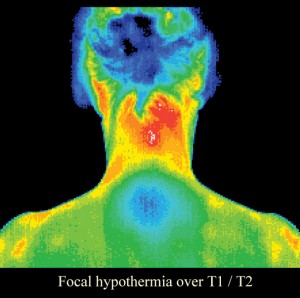By Taryn Kean, CCT Level III –


Medical DITI has been used extensively in human medicine in the U.S.A., Europe and Asia for the past 20 years to:
- Define the extent of a lesion of which a diagnosis has previously been made.
- Localize an abnormal area not previously identified, so further diagnostic tests can be performed.
- Detect early lesions before they are clinically evident.
- Monitor the healing process before the patient is returned to work or training.
Patterns of hypothermia seen over T1/T2 in a thermography scan are always indicative of autoimmune dysfunction. Interestingly enough, the Chinese have used this point in acupuncture for over 4000 years to stimulate immune function. This pattern is often seen in patients diagnosed with Fibromyalgia, a disorder that is very difficult to diagnose but is characterized by widespread musculoskeletal pain, accompanied by fatigue, sleep, memory and mood issues; as well as patients diagnosed with Chronic Fatigue Syndrome. Fibromyalgia patients will often have myofascial inflammation accompanying the hypothermic pattern. Thermography is useful in confirming a suspected diagnosis of these syndromes as well as monitoring the patient’s response to treatment. As the patient improves the hypothermic foci will experience a reduction in temperature differentials and will reduce. Conversely, if the patient is not responding to treatment or is regressing, this pattern will either maintain or the temperature differentials will increase and the pattern will become more pronounced.
Thermography can easily detect thyroid dysfunction even when all of the thyroid levels are within normal levels in the patient’s blood work. While DITI cannot determine if there is hypothyroidism or hyperthyroidism, it can only determine that there is dysfunction within the thyroid. DITI can also validate the appropriate levels of thyroid supplementation. For example if a patient is on thyroid medication and no patterns appear on the thermogram related to thyroid, it can then be assumed that he or she is receiving the adequate amount of medication or supplementation.
DITI can assist in the diagnosis, evaluation, monitoring and documentation of a large number of injuries and conditions, including soft tissue injuries and sensory/autonomic nerve fiber dysfunction. DITI is unique in that it is a test of physiology and function and can offer considerable financial savings by eliminating the need for additional expensive and invasive diagnostic testing.
Medical DITI is a monitor of thermal abnormalities present in a number of diseases and physical injuries. It is used as an aid for diagnosis and prognosis, as well as therapy follow up and rehabilitation monitoring, within clinical fields that include Rheumatology, Neurology, Physiotherapy, Sports Medicine, Oncology, Pediatrics, Orthopedics and many others.
Southwest Medical Thermal Imaging
239.949.2011
www.ThermalClinic.com
 Southwest Florida's Health and Wellness Magazine Health and Wellness Articles
Southwest Florida's Health and Wellness Magazine Health and Wellness Articles
